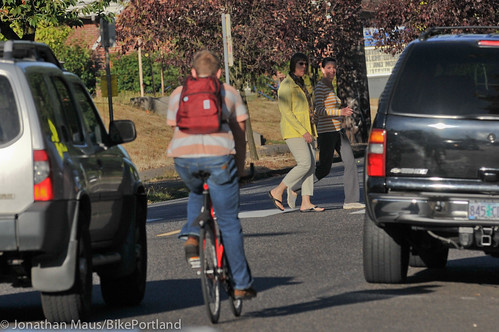
(Photos J. Maus/BikePortland)
How do you get people to slow down and drive safely near school zones? Infrastructure and good street design can do a lot; but like most U.S. cities, we haven’t invested as much as we should in that regard.
On the other end of the solution spectrum is figuring out how to balance punishment for breaking laws while education the public at the same time. And for the Portland Bureau of Transportation, “crosswalk enforcement actions” hit that sweet spot.
For about 10 years now, Sharon White from PBOT’s Community and Schools Traffic Safety Parntership, has been organizing an average of about one of these actions per month. And they’re quite effective. In 2011 we reported that the Portland Police Bureau wrote 904 citations in the program’s first five years. Beyond punishment though, the success of the program is measured in how far word spreads about crosswalk and speeding laws.
White works with the community and the PPB Traffic Division to determine where to have the actions and then puts herself in harm’s way as a crosswalk decoy. This morning out at NE 22nd and Killingsworth, she was joined by PBOT Director Leah Treat at a marked crosswalk just steps from the main entrance to Vernon elementary school. The two women walked across the street dozens of times while Traffic Division officers waited on side streets for speeders, crosswalk law violators, and cell phone users.
For people traveling on Killingsworth, the school zone signs themselves should be enough of a warning to drive safely; but during these actions the city adds signs that read: “Pedestrian Crosswalk Enforcement Ahead.” While some people say that takes away the element of surprise and defeats the purpose of the mission, the PPB and PBOT see it differently.
“This is all about education,” said Sgt. Robert Voepel as he peered through his radar gun while seated on his motorcycle. Another benefit of the sign, according to PBOT spokesman Dylan Rivera, is that it makes it easier for the police to defend tickets if they are taken to traffic court. Sgt. Voepel said these enforcement actions don’t usually result in any contested tickets, mostly because he offers everyone the option to take the Share the Road Safety Class in lieu of a ticket.
But for one women stopped by Sgt. Voepel this morning, that class won’t be an option. She was doing 34 in a 20 mile per zone, which amounts to a $360 ticket. “The class isn’t an option for speeders,” he pointed out, “And she also didn’t stop for the pedestrians.”
Vernon School principal Tina Acker, who joined White and Treat out at the intersection this morning, said she was “thrilled” to have the city’s attention on traffic safety around her school. “We’ve only been in school for three days, and look, they’ve already stopped lots of people.” Acker said one of her teachers was almost hit in the crosswalk yesterday. She and other staff take down license plate numbers and tally traffic safety complaints from the school community. They then give those complaints to their assigned School Resource Officer who runs them up the flagpole at the PPB and eventually onto PBOT.
As I chatted with Acker, she became distracted. “Right there! She’s speeding!” she yelled as she pointed to a dangerous driver that had just passed by her school’s front door. Hoping one of the three police officers on the scene saw the violation, we waited. Then we saw the sirens and the stop was made. “He got her!” Acker said, smiling.


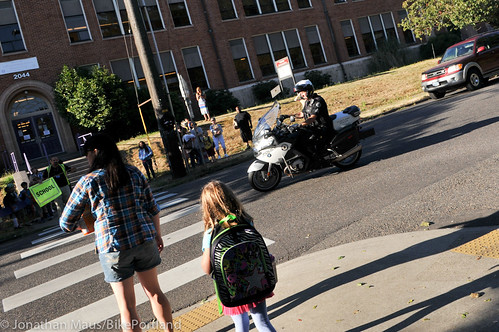
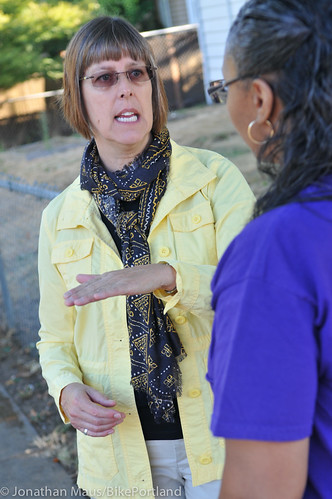

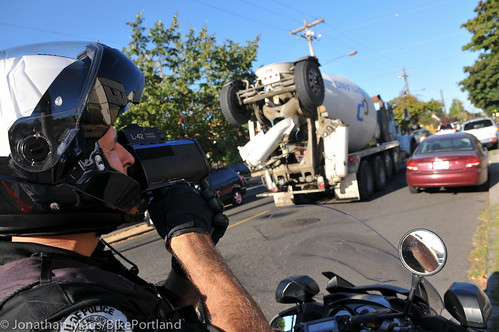
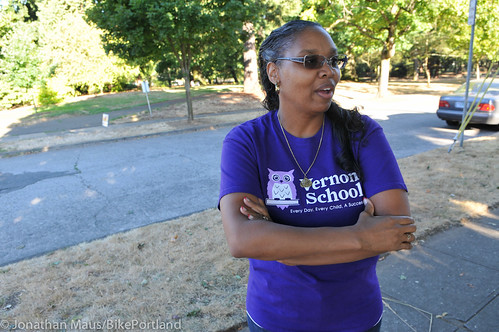
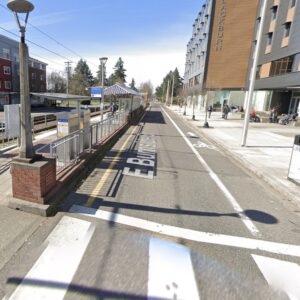
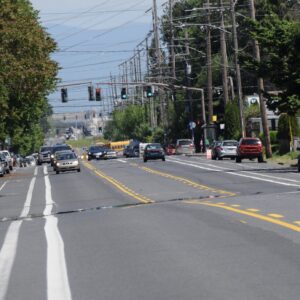
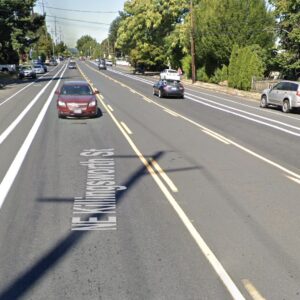
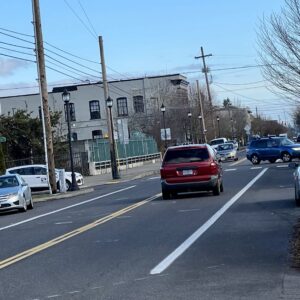
Thanks for reading.
BikePortland has served this community with independent community journalism since 2005. We rely on subscriptions from readers like you to survive. Your financial support is vital in keeping this valuable resource alive and well.
Please subscribe today to strengthen and expand our work.
Given the recent report that drivers in Portland are less likely to stop for African-Americans, it might be interesting for crosswalk enforcement to have two darker-skinned people as decoys. I wonder if people would be less likely to stop?
do you have a source for that? I’d like to learn more.
The PSU summary: http://www.pdx.edu/clas/news/study-examines-racial-bias-crosswalks
The research report: http://www.pdx.edu/clas/news/study-examines-racial-bias-crosswalks
Oregonian coverage: http://www.oregonlive.com/commuting/index.ssf/2014/05/portland_drivers_clearly_exhib.html
Thanks very much. Intriguing, of also troubling, research.
Wow. I can’t say that I’m surprised, but you’ve got:
A school zone, a crosswalk, a freakin’ sign that announces the enforcement, and a cop on a motorcycle with a radar gun and you STILL can’t operate your vehicle responsibly?
Thanks PPB and PBOT. I wish these could happen every day across the city.
You’d think with all those many ways of g(failing to) get their attention they’d get another ticket for driving distracted.
More enforcements at unmarked crosswalks, please.
@daisy — that’s a great comment. I’m going to work on that.
Do any schools in Portland have the flashing 20mph lights for when before and after school? I don’t see any in the schools around me. I always thought those signs were pretty effective in other places I have lived. They kind of jolt you out of the rut you can be in driving your familiar routes.
Vernon has them. I lived down the street for 10 years and found that most people went 20 when they were flashing, at least when I was driving. But judging from this story, obviously not everyone does.
I’d like to see some crosswalk enforcement on NE Prescott. In dozens of pedestrian crossings over the years, I think one car ever stopped for me.
They are typically used on higher classified streets, like 92nd at Cooper (Kelly), Vermont (Rieke), etc. They are only activated before school starts and after the school lets out (computers and pagers!), so the 20 mph is only in effect while they are flashing, not other times when children are present.
SE Division, by Richmond Elementary and further east by Atkinson/Franklin, has the flashing lights.
I’d be happy to be a decoy at 41/43/45 and Division.
“but during these actions the city adds signs that read: ‘Pedestrian Crosswalk Enforcement Ahead.'”
Am I remembering correctly that there are no signs put up at Ladd’s Addition when the target is people bicycling?
Looks like I remembered correctly.
http://bikeportland.org/2012/05/24/13-citations-issued-by-ppb-in-crosswalk-enforcement-action-72264#comment-2932743
The discrepancy to me speaks volumes.
Situation A
People driving are recognized to be lax in their crosswalk+pedestrian compliance behavior, so PPB & PBOT focus on ‘educating them.’
: peopled crosswalk, driver blows through = education
Situation B
People biking are recognized to have low compliance with stop signs, so PPB hands them all tickets and skips the pre-announcing part.
: (mostly) empty intersection with stop sign, biker blows through = ticket
I may be wrong about this, but isn’t the focus in Ladd’s on the stop sign, not on persons wanting to cross there as in the school crosswalk enforcement situation? My hunch would be that during those stings most of the time there are probably no people present trying to cross. I’d love to hear PBOT’s take on this. Thanks.
The target in Ladd’s is people running a stop sign. The target here is people who fail to yield to pedestrians in a crosswalk. I know for a fact that cars were ticketed in Ladd’s Addition, and bikes have been ticketed in previous crosswalk stings.
In other words the behavior is being ticketed, not the mode of travel. Enough with the persecution complex.
you haven’t spoken to the discrepancy where warning signs are only deployed for the crosswalk events, is called an educational event (where only the most egregious violators might get an actual ticket), and what goes down in Ladd’s, which differs, as far as I’ve understood it, on all three counts.
And hopefully this’ll also make you feel a little less persecuted:
“In the case of the Springwater/Spokane complaint, Engstrom said he responds by assigning one of his officers to the area to write citations and/or warn people as appropriate. Most of the people who are stopped are given the option to attend the Share the Road Safety Class in lieu of the fine and ticket.”
In other words: some people get warnings, and the folks who get ticketed have the option of going to a class instead of paying the fine. Just like the crosswalk enforcement action.
“Whenever one of the enforcement missions involves bicycling, the Traffic Division’s bicycle liaison officer passes along the location and the issue to BikePortland and the Bicycle Transportation Alliance in hopes of spreading the word prior to the mission.”
They also warn people in advance of the mission, and sit out in plain view during the enforcement mission.
The funny thing about phrases like ‘persecution complex’ or ‘conspiracy theory’ is that they are bandied about by people who (apparently) think that there is no persecution, there are no conspiracies. In the world I live in both occur, and (trying to) shut down conversation with those phrases doesn’t help us understand when and under what circumstances bias or worse manifests itself.
I’ll be happy to learn that the two enforcement actions are as similar in design and outcome as you seem to think. But I’m not satisfied quite yet. Maybe I’ll ask Sharon White for comment during regular business hours.
Thanks.
I was quoting an article written by Jonathan Maus on BikePortland.org. Have you heard of him? He’s not your typical auto-centric media correspondent.
I’d think the fact that both modes of travel get ticketed/warned in both types of stings, and that stop sign enforcement actions also have advance warning (as evidenced by this very blog) would be reason enough evidence to counter your assertion that the PPD is looking to mess with cyclists specifically. But generally people who believe in conspiracies tend to refute evidence whenever it’s offered.
It shouldn’t take any additional signage to justify giving someone in the wrong a ticket so there being a difference shouldn’t matter. Heck should we have more warning signs for all laws that are already out there and maybe all police should have an entourage just to let you know they are nearby so you shouldn’t break the law at that moment. It would be nice if they could just trust you won’t break the law. You broke the law or endangered others in both scenarios. Just today on my ride in to work through Ladds an older lady was having trouble crossing the street because the cyclists wouldnt stop at the stop sign (and crosswalk) for her. When I stopped for her people kept swooping around nearly striking her. Ya did wrong so deal with the consequences and don’t get all hurt when called out on it trying to make it seem so unfair.
“It shouldn’t take any additional signage to justify giving someone in the wrong a ticket so there being a difference shouldn’t matter.”
You completely missed the point I was trying to make. I’m not interested in a black and white accounting of traffic infractions, as if they’re all equivalent and the only thing that matters is nabbing people.
How PBOT goes about this, what their objectives and decision rules are is what I was getting at. I understand that this is of not interest to you, but perhaps you can appreciate that some of us do find it interesting.
Also—and I’m not sure how you could have missed this—if the sign allows the person to avoid the ticket by throttling their speed, paying closer attention, or whatever, then surely any asymmetric deployment of these signs is consequential.
You’re confusing PBOT with PPB. PBOT requests crosswalk enforcements as part of it’s pedestrian safety campaign. PPB does stop sign enforcements. Ask them why.
I don’t think I’m confusing any of the City’s agencies. Both of these actions are focused on pedestrian safety; both involve cops on motorcycles; both involve apprehending citizens who are not complying with traffic control devices. If the two agencies have different decision rules, well, then that is what I’m interested in understanding. Given that there’s so much overlap between these two actions, the least I can expect as a taxpayer is that the right hand and the left hand coordinate a little.
Glad to hear they are targeting people on cell phones too. I’d love to see a breakdown of how many people pulled over and what for.
There’s a report link on this page:
http://www.portlandoregon.gov/transportation/article/384967?archive=2012-02
I still think it is ridiculous that the police have to put up warning signs to “defend the ticket.” Doesn’t putting up the sign just send the motorists a message that “we don’t usually care, but, today, we actually expect you to obey the law?”
I also find it outrageous that the motorist driving almost twice the legal limit (34 in a 20 zone) and who also failed to yield to pedestrians in a crosswalk gets a ticket for only $360. Those are two very dangerous things. Why isn’t each one $500?
Finally, the article claims “904 citations in the first five years.” What? That’s fewer than four citations per week. Less than one per day. Every day, I see at least one motorist fail to yield to a pedestrian; at least one motorist roll through a stop sign; and at least one motorist run a red light. It’s readily apparent that enforcing the laws that seek to protect pedestrians is a really low priority.
“I also find it outrageous that the motorist driving almost twice the legal limit (34 in a 20 zone) and who also failed to yield to pedestrians in a crosswalk gets a ticket for only $360. Those are two very dangerous things. Why isn’t each one $500?”
Hi J_R,
You must be someone who has a decent income. $360 is half of one of my paychecks….So that would be QUITE a lot of money for me. $1,000 would pretty much create disastrous affects, Can’t pay rent, can’t pay bills, etc.
I think it’s hard for different income earners to be properly penalized with a one fine fits all type of method. For some it does too much and others too little.
Totally agree. We need a sliding fee for traffic violations, as they have in some Scandinavian countries.
I’ve also observed, anecdotally of course, that drivers are less likely to stop for a male, more likely to stop if there is a baby carriage involved, much less likely to stop if you’re on a bicycle, and can be made to stop if you hold up your camera phone like you’re filming them. In fact, you don’t even have to use a phone. Sometimes I hold up my wallet and pretend to be filming with it. Inevitably, they will stop and then glower at you.
Lastly, we desperately need more enforcement on MLK between Fremont and Ainsworth. It’s the worst along there.
Yeah, they can’t see you, but they can see the phone. Or the key in my outstretched hand — and *they* think they’re the ones who are being rudely threatened.
“$360 is half of one of my paychecks….So that would be QUITE a lot of money for me.”
Isn’t that the point? Dangerous behavior like this should be penalized in a way that hurts, that discourages this sort of thing. It is pretty easy to avoid, after all.
But of course the income based speeding tickets common in Europe are fantastic. A cool million and a half ticket and the car impounded for a super rich dude’s 200mph speeding. Why not?
OK. So make it 20 hours of community service. The consequences should be significant enough to cause greater compliance. There’s so little chance of getting caught and a lack of meaningful consequences, that there is little compliance with traffic laws that directly affect pedestrian and child safety – this was in a school zone.
If you don’t want to suffer the consequences (cash or time), obey the law. That motorist (who’d I “throw the book at”) put people at risk to save, maybe, 30 seconds by flying through a school zone.
J_R,
You are aware that the State Legislature sets traffic infraction maximum penalties, and lowest levle such fines can be reduced to, not the City or the Courts?
Also, PBOT requests crosswalk enforcement actions about once a month. The media rarely show up any more.